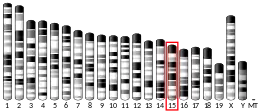MYC
MYC proto-oncogene, bHLH transcription factor is a protein that in humans is encoded by the MYC gene[5] which is a member of the myc family of transcription factors. The protein contains basic helix-loop-helix (bHLH) structural motif.
Function
This gene is a proto-oncogene and encodes a nuclear phosphoprotein that plays a role in cell cycle progression, apoptosis and cellular transformation. The encoded protein forms a heterodimer with the related transcription factor MAX. This complex binds to the E box DNA consensus sequence and regulates the transcription of specific target genes. Amplification of this gene is frequently observed in numerous human cancers. Translocations involving this gene are associated with Burkitt lymphoma and multiple myeloma in human patients. There is evidence to show that translation initiates both from an upstream, in-frame non-AUG (CUG) and a downstream AUG start site, resulting in the production of two isoforms with distinct N-termini. [provided by RefSeq, Aug 2017].
References
- GRCh38: Ensembl release 89: ENSG00000136997 - Ensembl, May 2017
- GRCm38: Ensembl release 89: ENSMUSG00000022346 - Ensembl, May 2017
- "Human PubMed Reference:". National Center for Biotechnology Information, U.S. National Library of Medicine.
- "Mouse PubMed Reference:". National Center for Biotechnology Information, U.S. National Library of Medicine.
- "Entrez Gene: MYC proto-oncogene, bHLH transcription factor". Retrieved 2020-03-02.
Further reading
- Hann SR, King MW, Bentley DL, Anderson CW, Eisenman RN (January 1988). "A non-AUG translational initiation in c-myc exon 1 generates an N-terminally distinct protein whose synthesis is disrupted in Burkitt's lymphomas". Cell. 52 (2): 185–95. doi:10.1016/0092-8674(88)90507-7. PMID 3277717. S2CID 3012009.
- Hiyama T, Haruma K, Kitadai Y, Ito M, Masuda H, Miyamoto M, Tanaka S, Yoshihara M, Sumii K, Shimamoto F, Chayama K (2001). "c-myc gene mutation in gastric mucosa-associated lymphoid tissue (MALT) lymphoma and diffuse large B-cell lymphoma". Oncol. Rep. 8 (2): 289–92. doi:10.3892/or.8.2.289. PMID 11182042.
- Ruf IK, Rhyne PW, Yang H, Borza CM, Hutt-Fletcher LM, Cleveland JL, Sample JT (2001). "EBV regulates c-MYC, apoptosis, and tumorigenicity in Burkitt's lymphoma". Curr. Top. Microbiol. Immunol. Current Topics in Microbiology and Immunology. 258: 153–60. doi:10.1007/978-3-642-56515-1_10. ISBN 978-3-642-62568-8. PMID 11443860.
- Hu HM, Arcinas M, Boxer LM (March 2002). "A Myc-associated zinc finger protein-related factor binding site is required for the deregulation of c-myc expression by the immunoglobulin heavy chain gene enhancers in Burkitt's lymphoma". J. Biol. Chem. 277 (12): 9819–24. doi:10.1074/jbc.M111426200. PMID 11777933.
- Hilker M, Tellmann G, Buerke M, Moersig W, Oelert H, Lehr HA, Hake U (2001). "Expression of the proto-oncogene c-myc in human stenotic aortocoronary bypass grafts". Pathol. Res. Pract. 197 (12): 811–6. doi:10.1078/0344-0338-00164. PMID 11795828.
- Feng XH, Liang YY, Liang M, Zhai W, Lin X (January 2002). "Direct interaction of c-Myc with Smad2 and Smad3 to inhibit TGF-beta-mediated induction of the CDK inhibitor p15(Ink4B)". Mol. Cell. 9 (1): 133–43. doi:10.1016/s1097-2765(01)00430-0. PMID 11804592.
- Geick A, Redecker P, Ehrhardt A, Klocke R, Paul D, Halter R (December 2001). "Uteroglobin promoter-targeted c-MYC expression in transgenic mice cause hyperplasia of Clara cells and malignant transformation of T-lymphoblasts and tubular epithelial cells". Transgenic Res. 10 (6): 501–11. doi:10.1023/a:1013085228119. PMID 11817538. S2CID 2305422.
- Kuschak TI, Kuschak BC, Taylor CL, Wright JA, Wiener F, Mai S (January 2002). "c-Myc initiates illegitimate replication of the ribonucleotide reductase R2 gene". Oncogene. 21 (6): 909–20. doi:10.1038/sj.onc.1205145. PMID 11840336.
- Chettab K, Zibara K, Belaiba SR, McGregor JL (January 2002). "Acute hyperglycaemia induces changes in the transcription levels of 4 major genes in human endothelial cells: macroarrays-based expression analysis". Thromb. Haemost. 87 (1): 141–8. doi:10.1055/s-0037-1612957. PMID 11848444.
This article incorporates text from the United States National Library of Medicine, which is in the public domain.




